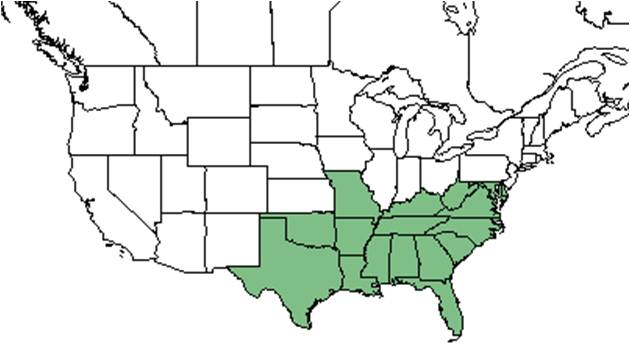Vitis rotundifolia
| Vitis rotundifolia | |
|---|---|

| |
| Photo by Kevin Robertson | |
| Scientific classification | |
| Kingdom: | Plantae |
| Division: | Magnoliophyta - Flowering plants |
| Class: | Magnoliopsida – Dicotyledons |
| Order: | Rhamnales |
| Family: | Vitaceae |
| Genus: | Vitis |
| Species: | V. rotundifolia |
| Binomial name | |
| Vitis rotundifolia Michx. | |

| |
| Natural range of Vitis rotundifolia from USDA NRCS Plants Database. | |
Common name: Muscadine
Contents
Taxonomic notes
Synonyms: Muscadinia rotundifolia (Michaux) Small var. rotundifolia; Vitis rotundifolia Michaux var. rotundifolia; Muscadinia rotundifolia (Michaux) Small
Description
"High-climbing or trailing vines; pith brown, continuous or discontinuous through the nodes. Leaves simple, acute or acuminate, serrate, base cordate, petiolate. Inflorescences paniculate. Calyx flat, round, usually without lobes; petals 5, 0.5-2.5 mm long, cohering at the summit, separating at the base, falling at anthesis; disk of 5 connate or separate glands, 0.2-0.4 mm long; stigmas small, style conical, 0.2-0.5 mm long. Berry dark purple, globose; seeds 1-4 usually red or brown, pyriform, 4-7 mm long." [1]
"High-climbing vine with adhering bark, conspicuous tendrils, and pith continuous through node; young branches angled, puberulent. Leaves suborbicular or widely ovate, to 8 cm long or wide, glabrate or glabrous. Mature inflorescences to 5 cm long, few-fruited; berries 1-2 cm in diam.; seeds ca. 6 mm long." [1]
Distribution
Ecology
V. rotundifolia responds negatively to agricultural-based soil disturbance in South Carolina coastal plain communities. This marks it as a possible indicator species for remnant woodland.[2]
Phenology
V. rotundifolia has been observed flowering from March to May and in July with peak inflorescence in May.[3]
Seed dispersal
This species is thought to be dispersed by consumption by vertebrates. [4]
Pollination
The following Hymenoptera families and species were observed visiting flowers of Vitis rotundifolia at Archbold Biological Station: [5]
Apidae: Apis mellifera, Bombus impatiens
Halictidae: Agapostemon splendens, Augochloropsis anonyma, A. sumptuosa, Lasioglossum placidensis
Megachilidae: Megachile brevis pseudobrevis, M. mendica, M. petulans
Conservation and management
Cultivation and restoration
Photo Gallery
References and notes
- ↑ 1.0 1.1 Radford, Albert E., Harry E. Ahles, and C. Ritchie Bell. Manual of the Vascular Flora of the Carolinas. 1964, 1968. The University of North Carolina Press. 695. Print.
- ↑ Brudvig, L.A., E Grman, C.W. Habeck, and J.A. Ledvina. (2013). Strong legacy of agricultural land use on soils and understory plant communities in longleaf pine woodlands. Forest Ecology and Management 310: 944-955.
- ↑ Nelson, G. PanFlora: Plant data for the eastern United States with emphasis on the Southeastern Coastal Plains, Florida, and the Florida Panhandle. www.gilnelson.com/PanFlora/ Accessed: 15 DEC 2016
- ↑ Kirkman, L. Katherine. Unpublished database of seed dispersal mode of plants found in Coastal Plain longleaf pine-grasslands of the Jones Ecological Research Center, Georgia.
- ↑ Deyrup, M.A. and N.D. 2015. Database of observations of Hymenoptera visitations to flowers of plants on Archbold Biological Station, Florida, USA.